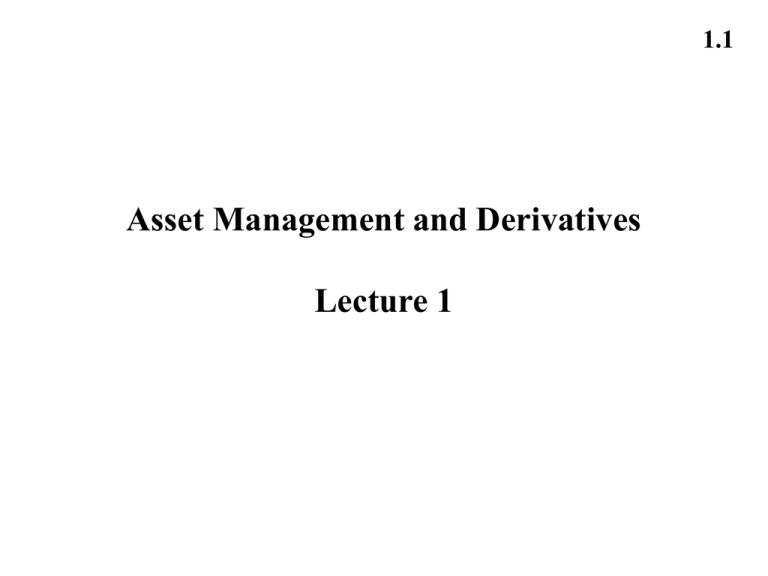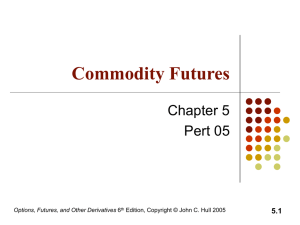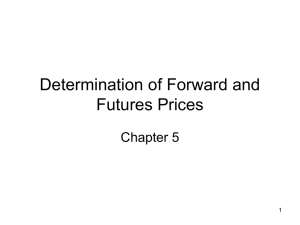Asset Management and Derivatives Lecture 1 1.1
advertisement

1.1 Asset Management and Derivatives Lecture 1 1.2 Course objectives Why an asset management course on derivatives? A derivative is an instrument whose value depends on the values of other more basic underlying variables. Examples: swaps, futures, options, ... 1. They can increase the efficiency of the investment process 2. Their non-linear payoff can be attractive for improving the risk-return profile of the managed portfolio 3. We can borrow from their hedging/pricing techniques new ways of managing portfolios 4. They can enlarge the asset classes on which we can invest 1.3 Improve the efficiency • a quicker way for tactical market timing. Imagine that you are the manager of an equity fund and you want to take a positive bet on the entire stock market (+1% on the benchmark). Since you are actually neutral and you want to go long, you can borrow money and buy all the stocks that are in your portfolio in the existing proportions. This is a complex operation. The typical shortcut is through a futures contract. • if you want to replicate an index where a single stock weights more than the max allowed by regulators, you have to resort to derivates to reach synthetically the desired exposure. • another example of use of derivatives is when you want to hedge your fund from currency fluctuations. 1.4 Modify risk-return mapping • traditional long-only asset management has a linear pay-off • one can use derivative both for going short and for introducing some nonlinearity in a fund which remains in any case essentially long-only • Apart from the “simple” buying or selling of options either because of particular views that we have on stock/market or because of arbitrage opportunities between the cash and the derivatives market, we can use derivatives to tilt the management result on a given time horizon. This can be useful if you want a floor on your profits (think about the possibility of lockingin the profits through a put option) ... or if you want a cap (think about the possibility of improving your return by selling an out-of-the money call option on a stock held in your portfolio. • In any case, you may end up buying options also if are not perfectly aware of it (see convertible bonds). So beware 1.5 new ways of managing money • Derivatives can be useful to learn new ways of managing money and then structuring products helpful for more sophisticated clients’ needs. • The pricing of a derivatives is based on the concept that if market is efficient there should be no arbitrage opportunities between the cash market and the derivatives. • The pricing is then strictly linked to replicating the pay-off of the derivatives via a portfolio of basic financial instrument. The portfolio has to be managed dynamically. • So it is possible to manage a fund in a way that it replicates the pay-off of an option. This principle is behind portfolio insurance and other dynamic techniques that are currently used in the asset management industry. 1.6 enlarging the universe • Many asset classes cannot be invested in, by regulatory reasons and by objective difficulties inherent to the markets nature. Those asset classes might be very useful in diversifiyng the portfolio. • For example, it can be very difficult to access certain emerging markets, either because they are protected by cumbersome administrative rules or simply because foreign investors are not allowed to hold them. • Another example is instead the one of an asset class that cannot be accessed by an asset manager because of the market’s nature. •Think about mortgages or loans. This is a market that can be accessed only by banks. Credit derivatives are a new class of financial instruments that allow an asset manager to access them. •Think about re-insurance risks (weather or earthquake risks). ART instruments can help asset managers to access them 1.7 The Playground 1.8 Derivatives Markets • Exchange Traded – standard products – trading floor or computer trading – virtually no credit risk • Over-the-Counter – non-standard products – telephone market – some credit risk 1.9 Types of Traders • Hedgers • Speculators • Arbitrageurs Some of the large trading losses in derivatives occurred because individuals who had a mandate to hedge risks switched to being speculators 1.10 Hedging Examples • A US company will pay £1 million for imports from Britain in 6 months and decides to hedge using a long position in a forward contract • An investor owns 500 IBM shares currently worth $102 per share. A twomonth put with a strike price of $100 costs $4. The investor decides to hedge by buying 5 contracts 1.11 Speculation Example • An investor with $7,800 to invest feels that Exxon’s stock price will increase over the next 3 months. The current stock price is $78 and the price of a 3month call option with a strike of 80 is $3 • What are the alternative strategies? 1.12 Arbitrage Example • A stock price is quoted as £100 in London and $172 in New York • The current exchange rate is 1.7500 • What is the arbitrage opportunity? 1.13 Forward Contracts • A forward contract is an agreement to buy or sell an asset at a certain time in the future for a certain price (the delivery price) • It can be contrasted with a spot contract which is an agreement to buy or sell immediately 1.14 How a Forward Contract Works • The contract is an over-the-counter (OTC) agreement between 2 companies • The delivery price is usually chosen so that the initial value of the contract is zero • No money changes hands when contract is first negotiated and it is settled at maturity The Forward Price • The forward price for a contract is the delivery price that would be applicable to the contract if were negotiated today (i.e., it is the delivery price that would make the contract worth exactly zero) • The forward price may be different for contracts of different maturities 1.15 1.16 Terminology • The party that has agreed to buy has what is termed a long position • The party that has agreed to sell has what is termed a short position 1.17 Example • On January 20, 1998 a trader enters into an agreement to buy £1 million in three months at an exchange rate of 1.6196 • This obligates the trader to pay $1,619,600 for £1 million on April 20, 1998 • What are the possible outcomes? 1.18 Profit from a Long Forward Position Profit K Price of Underlying at Maturity, ST 1.19 Profit from a Short Forward Position Profit K Price of Underlying at Maturity, ST 1.20 Futures Contracts • Agreement to buy or sell an asset for a certain price at a certain time • Similar to forward contract • Whereas a forward contract is traded OTC a futures contract is traded on an exchange 1.21 Exchanges Trading Futures • • • • • • Chicago Board of Trade Chicago Mercantile Exchange BM&F (Sao Paulo, Brazil) LIFFE (London) TIFFE (Tokyo) and many more (see list at end of book) 1. Gold: An Arbitrage Opportunity? • Suppose that: - The spot price of gold is US$300 - The 1-year forward price of gold is US$340 - The 1-year US$ interest rate is 5% per annum • Is there an arbitrage opportunity? 1.22 1.23 2. Gold: Another Arbitrage Opportunity? • Suppose that: - The spot price of gold is US$300 - The 1-year forward price of gold is US$300 - The 1-year US$ interest rate is 5% per annum • Is there an arbitrage opportunity? 1.24 The Forward Price of Gold If the spot price of gold is S & the forward price for a contract deliverable in T years is F, then F = S (1+r )T where r is the 1-year (domestic currency) riskfree rate of interest. In our examples, S=300, T=1, and r=0.05 so that F = 300(1+0.05) = 315 1.25 Gold Example • For the gold example, F0 = S0(1 + r )T (assuming no storage costs) • If r is compounded continuously instead of annually F0 = S0erT When an Investment Asset Provides a Known Dollar Income (page 58) F0 = (S0 – I )erT where I is the present value of the income 1.26 When an Investment Asset Provides a Known Dividend Yield F0 = S0 e(r–q )T where q is the average dividend yield during the life of the contract 1.27 Valuing a Forward Contract 1.28 Page 59 • Suppose that K is delivery price in a forward contract & F0 is forward price that would apply to the contract today • The value of a long forward contract, ƒ, is ƒ = (F0 – K )e–rT • Similarly, the value of a short forward contract is (K – F0 )e–rT 1.29 Stock Index • Can be viewed as an investment asset paying a continuous dividend yield • The futures price & spot price relationship is therefore F0 = S0 e(r–q )T where q is the dividend yield on the portfolio represented by the index 1.30 Stock Index (continued) • For the formula to be true it is important that the index represent an investment asset • In other words, changes in the index must correspond to changes in the value of a tradable portfolio • The Nikkei index viewed as a dollar number does not represent an investment asset 1.31 Index Arbitrage • When F0>S0e(r-q)T an arbitrageur buys the stocks underlying the index and sells futures • When F0<S0e(r-q)T an arbitrageur buys futures and shorts or sells the stocks underlying the index 1.32 Index Arbitrage (continued) • Index arbitrage involves simultaneous trades in futures & many different stocks • Very often a computer is used to generate the trades • Occasionally (e.g., on Black Monday) simultaneous trades are not possible and the theoretical no-arbitrage relationship between F0 and S0 may not hold 1.33 Hedging Using Index Futures • To hedge the risk in a portfolio the number of contracts that should be shorted is P b A • where P is the value of the portfolio, b is its beta, and A is the value of the assets underlying one futures contract 1.34 Changing Beta • What position in index futures is appropriate to change the beta of a portfolio from b to b* 1.35 Futures and Forwards on Currencies • A foreign currency is analogous to a security providing a continuous dividend yield • The continuous dividend yield is the foreign risk-free interest rate • It follows that if rf is the foreign risk-free interest rate F0 S0e ( r rf ) T 1.36 Futures on Consumption Assets F0 S0 e(r+u )T where u is the storage cost per unit time as a percent of the asset value. Alternatively, F0 (S0+U )erT where U is the present value of the storage costs. 1.37 The Cost of Carry • The cost of carry, c , is the storage cost plus the interest costs less the income earned • For an investment asset F0 = S0ecT • For a consumption asset F0 S0ecT • The convenience yield on the consumption asset, y , is defined so that F0 = S0 e(c–y )T 1.38 Futures Prices & Expected Future Spot Prices • Suppose k is the expected return required by investors on an asset • We can invest F0e–r T now to get ST back at maturity of the futures contract • This shows that F0 = E (ST )e(r–k )T Futures Prices & Future Spot Prices • If the asset has – no systematic risk, then k = r and F0 is an unbiased estimate of ST – positive systematic risk, then k > r and F0 < E (ST ) – negative systematic risk, then k < r and F0 > E (ST ) 1.39 1.40 1. Oil: An Arbitrage Opportunity? Suppose that: - The spot price of oil is US$19 - The quoted 1-year futures price of oil is US$25 - The 1-year US$ interest rate is 5% per annum - The storage costs of oil are 2% per annum • Is there an arbitrage opportunity? 1.41 2. Oil: Another Arbitrage Opportunity? • Suppose that: - The spot price of oil is US$19 - The quoted 1-year futures price of oil is US$16 - The 1-year US$ interest rate is 5% per annum - The storage costs of oil are 2% per annum • Is there an arbitrage opportunity?

